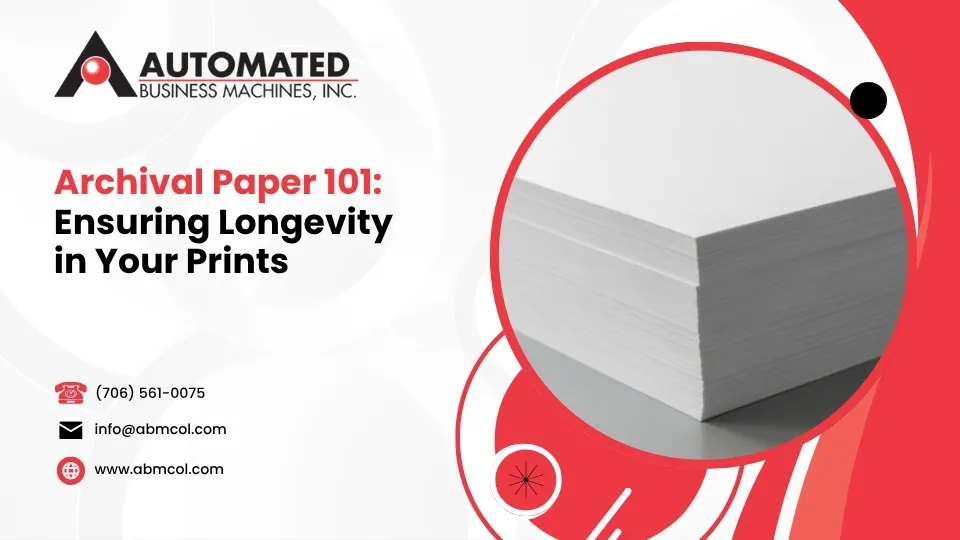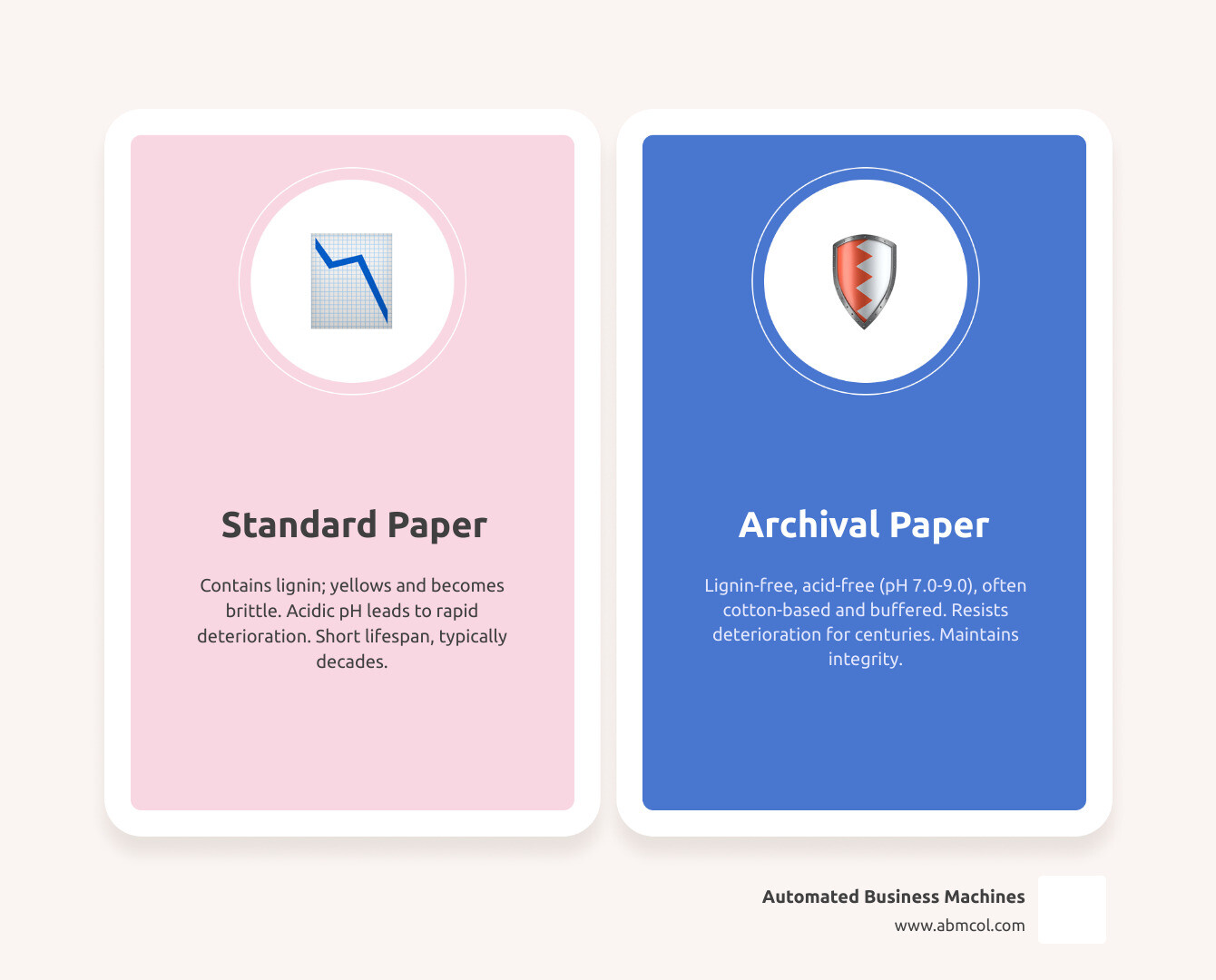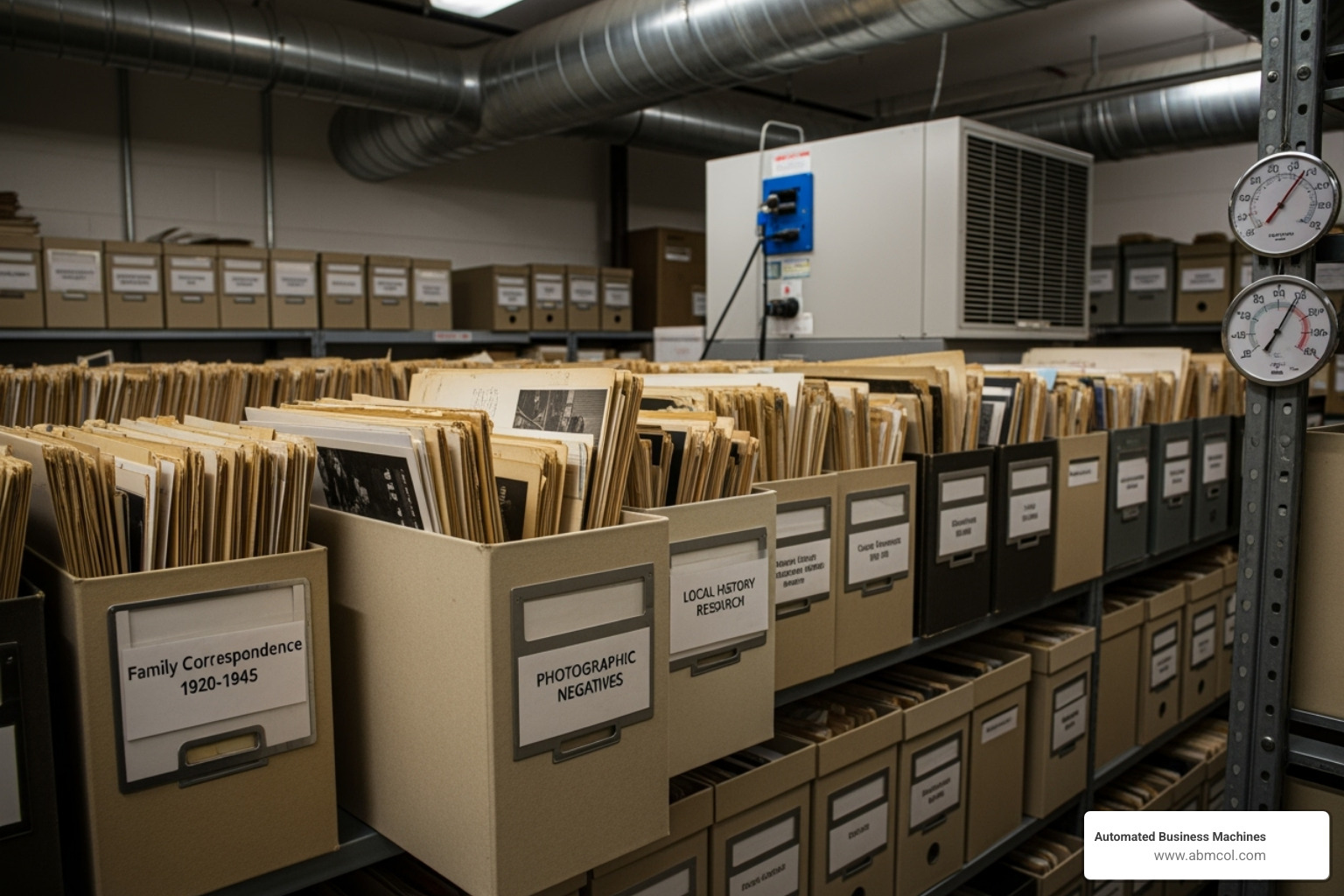
Archival quality printer paper is acid-free paper designed to resist deterioration for decades or even centuries. Unlike standard paper that yellows and becomes brittle over time, archival paper maintains its appearance and structural integrity through careful material selection and manufacturing processes.
Key characteristics of archival quality printer paper:
- pH neutral or alkaline (7.0-9.0 pH) to prevent acid damage
- Lignin-free composition to avoid yellowing and brittleness
- Cotton fiber content (typically 25-100%) for improved durability
- Buffered with calcium carbonate to resist acid migration
- Passes industry standards like the Photographic Activity Test (P.A.T.)
Have you ever opened an old photo album and found yellowed, crumbling pictures? That’s exactly what happens when regular paper meets time. The lignin in wood pulp breaks down, creating acids that destroy the paper from within.
Your important documents deserve better. Whether you’re preserving family photographs, creating professional portfolios, or archiving critical business records, the paper you choose determines whether these materials will last months or centuries.
Standard office paper might save you money upfront, but archival paper protects your investment in printing and ensures your most valuable documents remain pristine for future generations. The difference isn’t just academic – it’s the distinction between preservation and deterioration.
What Makes Paper ‘Archival’?
The secret behind archival quality printer paper lies in its carefully engineered composition. Unlike the paper sitting in your office drawer, archival paper is built like a fortress against time itself. Its chemical stability and physical durability work together to resist the environmental factors that turn ordinary documents into yellowed, crumbling relics.
Think of regular paper as wearing a cotton t-shirt in a thunderstorm – it might look fine at first, but it won’t hold up. Archival paper, on the other hand, is like wearing a high-tech rain jacket designed for extreme conditions. The best examples can last for multiple centuries without fading or deteriorating, assuming they’re stored properly.
What makes this possible? It all comes down to three critical factors: the paper’s pH balance, the type of fibers used, and whether it includes protective buffering agents.
Acid-Free and Lignin-Free: The Foundation of Longevity
Remember those old newspapers in your attic that turned yellow and started falling apart? That’s lignin at work – and it’s exactly what archival paper avoids.
The pH scale runs from 0 to 14, with 7 being neutral. Most regular paper contains acids from its manufacturing process or from lignin, a natural compound found in wood. These acids are like tiny vandals, slowly breaking down the paper’s structure from the inside out. That’s why newsprint, which is packed with lignin, quickly becomes brittle and yellow.
Archival quality printer paper maintains a neutral pH of 7 or leans slightly alkaline (between 7.0 and 9.0). This acid-free nature stops those destructive chemical reactions before they start. But here’s the real game-changer: true archival paper is completely lignin-free.
Lignin might give trees their strength, but it’s paper’s worst enemy. When exposed to light and air, lignin breaks down and releases acids that destroy the cellulose fibers. To eliminate this threat, manufacturers use chemical pulping processes to remove lignin and other impurities, creating what’s called “purified alpha cellulose pulp.”
This meticulous process ensures your important documents won’t become brittle shadows of their former selves. Instead of fighting a losing battle against chemistry, your prints get to age gracefully.
The Role of Fiber: Cotton Rag vs. Alpha Cellulose
Not all fibers are created equal, and this difference becomes crucial when you’re planning for decades of preservation.
Cotton rag content represents the gold standard in paper durability. Cotton fibers are naturally longer and stronger than wood pulp fibers, which translates to better resistance against tearing, folding, and general wear. Some archival quality printer paper contains 25% cotton content, like Permalife 20 lb. Bond Paper, which significantly boosts its durability without breaking the budget.
For the ultimate in longevity, 100% cotton rag paper reigns supreme. This paper is naturally acid-free and lignin-free, making it incredibly stable. Under optimal storage conditions, the finest cotton rag papers can last for multiple centuries without any signs of deterioration.
Alpha cellulose offers another excellent option, especially when cost is a consideration. While it starts as wood pulp, rigorous chemical processing removes all the lignin and other unstable components, leaving behind only the purest cellulose. This purification process makes alpha cellulose chemically stable and highly durable – often providing archival quality at a more accessible price point.
Both cotton and purified alpha cellulose give your documents the structural integrity they need to survive whatever the future brings.
Buffered vs. Unbuffered: Choosing the Right Protection
Even the best acid-free paper needs backup protection, which is where buffering comes into play. Think of it as an insurance policy for your documents.
Buffered paper contains an alkaline reserve, typically 2% or more calcium carbonate. This acts like a security guard, neutralizing any acids that might try to sneak in from external sources – whether that’s acidic storage boxes, environmental pollutants, or even unstable inks. The National Archives and Records Administration (NARA) strongly recommends buffered paper for storing most photographic materials, including black and white, color, and digital photography.
Unbuffered paper maintains a neutral pH of 7.0 without any alkaline reserve. While this might sound less protective, certain materials actually require this neutral environment to prevent unwanted chemical reactions.
| Feature | Buffered Paper | Unbuffered Paper |
|---|---|---|
| pH Level | Alkaline (usually 7.5-9.5) | Neutral (pH 7.0) |
| Alkaline Reserve | Contains calcium carbonate (e.g., 2-3%) | Does not contain an alkaline reserve |
| Purpose | Neutralizes migrating acids; prevents acidification | Provides a stable, neutral environment |
| Primary Uses | Most documents, photographs (color, B&W, digital), general storage, interleaving | Cyanotypes, architectural blueprints, dye transfer images, protein-based textiles (e.g., silk, wool), some color photographic materials where buffering could react with dyes |
For most printing applications, buffered paper provides the robust protection your documents need. However, if you’re working with specialized materials like cyanotypes, architectural blueprints, or protein-based textiles, unbuffered paper prevents potentially damaging chemical interactions.
The choice between buffered and unbuffered isn’t about better or worse – it’s about matching the right protection to your specific preservation needs.
Understanding the Core Components of Archival Quality Printer Paper
When you’re investing in archival quality printer paper, you’re making a smart choice that goes beyond just having something that feels nice in your hands. You’re selecting a carefully crafted product designed to keep your most important materials looking fresh for generations – whether that’s critical business records, treasured family photos, or professional portfolios that showcase your best work.
Understanding what makes these papers special involves knowing how they work with different printing methods, how they interact with various inks, and most importantly, how to spot the real deal through proper certifications. After all, not all papers labeled as “archival” are created equal.
Decoding Labels: Certifications and Standards
How can you tell if a paper is truly archival and not just wearing the “acid-free” badge without earning it? The secret lies in looking for specific certifications and quality markers that separate the genuine articles from the pretenders.
ISO 9706 is one important standard that specifies requirements for “permanent” paper. This certification indicates a high level of age resistance, though it’s worth noting that while good, ISO 9706 might not be sufficient for fine art prints where you need brightness and optical properties to stay perfect for centuries. For documents that need permanent retention and frequent handling, ISO 11108 is another relevant standard to watch for.
The Photographic Activity Test (P.A.T.), specifically ISO IT 18916 or ISO 18902, is absolutely crucial for papers intended for photographic storage. This test determines whether a paper will cause fading, staining, or other damage to photographic images over time. When a paper passes the P.A.T., you can trust it with your precious prints. Permalife 20 lb. Bond Paper, for example, has passed this rigorous test, giving you real confidence in its archival capabilities.
Beyond these formal certifications, quality archival quality printer paper often includes other telltale signs of excellence. Watermarks are a classic indicator – many premium brands embed these subtle marks that become visible when you hold the paper up to light. They often serve as both a mark of authenticity and quality assurance.
Reputable manufacturers will also provide detailed specifications that include pH levels, buffering agents like calcium carbonate, cotton content percentages, and confirmation that harmful impurities are absent. Look for specifics like a Kappa number of less than five for lignin content and less than 0.0008% reducible sulfur content. These technical details might seem overwhelming, but they’re your roadmap to finding paper that will truly stand the test of time.
Choosing the Right Archival Quality Printer Paper for Your Needs
The “best” archival quality printer paper isn’t a one-size-fits-all answer – it depends entirely on what you’re trying to accomplish. Different papers are engineered for different purposes, offering various weights, finishes, and textures to match your specific needs.
Fine art paper is the premium choice for Giclée prints, photographs, and artistic reproductions. These papers often feature 100% cotton content and come with surfaces like cold press (which gives you that lovely textured feel) or hot press (perfectly smooth). The weights typically range from 250 gsm to 300 gsm or even 400 gsm, giving your prints a substantial, professional feel. You’ll find options like velvet, etching, or baryta papers that can mimic the look and feel of traditional darkroom prints.
For everyday business needs, bond paper is your reliable workhorse. A 20 lb. bond paper (around 75 gsm) with 25% cotton rag content offers excellent durability without being too thick for regular office use. It’s perfect for document printing, photocopying, and general archival storage where longevity matters but you don’t need the premium feel of art paper.
Interleaving paper serves a special protective purpose – these thin, acid-free tissue papers slip between prints, documents, or photographs to prevent acid migration and physical damage. They’re typically lightweight and may be unbuffered when needed for specific photo types like cyanotypes.
When you need extra structure, cardstock options like 110 lb or 67 lb weights provide the rigidity and durability perfect for covers, presentation materials, or documents that need to make a strong impression.
The surface finish you choose – whether matte, satin, soft gloss, or textured – affects both the look and feel of your final product. Matte finishes are particularly popular for fine art because they eliminate glare and allow colors to appear rich and deep, while soft gloss or satin can improve photographic prints with subtle shine.
The Critical Link Between Ink and Paper Permanence
Even the most perfect archival quality printer paper can’t work miracles on its own. The ink you choose is equally important for creating prints that last. Think of paper and ink as a team – neither can achieve true permanence without the right partner.
The key difference lies between pigment inks and dye-based inks, and understanding this distinction can make or break your archival goals.
Dye-based inks create beautiful, vibrant colors by dissolving colorants in liquid. They often produce a wider range of colors and can look absolutely stunning fresh off the printer. However, they have a weakness – the dissolved dye particles are small and vulnerable to fading when exposed to light, humidity, or environmental pollutants over time.
Pigment inks take a different approach, using solid, microscopic color particles suspended in liquid rather than dissolved. These larger, more stable particles resist fading, water damage, and environmental degradation much better than their dye-based cousins. They’re significantly more colorfast, meaning your prints will look nearly the same decades from now as they do today.
For archival printing, pigment inks are the clear winner. Systems like Canon’s LUCIA ink system are specifically designed to provide accurate color reproduction, outstanding image clarity, and improved detail while being highly colorfast. This combination contributes significantly to print longevity and ensures your important documents maintain their fade resistance over time.
While dye ink technology has improved over the years, pigment inks remain the gold standard for anything you want to preserve for decades or centuries. When you pair acid-free, lignin-free, buffered paper with high-quality pigment inks, you’re creating the ideal conditions for maximum color stability and print permanence – protecting your valuable materials from becoming faded memories.
Best Practices for Printing, Storing, and Displaying
You’ve invested in the perfect archival quality printer paper and chosen high-quality pigment inks. But here’s the thing – even the most carefully crafted materials need a little TLC to reach their full potential. Think of it like buying a classic car: you wouldn’t park it outside in all weather and expect it to stay pristine, right?
Environmental factors can be surprisingly sneaky. They work slowly but relentlessly, turning your beautiful prints into faded memories if you’re not careful. The good news? With some simple precautions, you can help your documents and photos last for generations.
Can I Use Archival Quality Printer Paper in My Regular Printer?
This question comes up all the time, and we love hearing it! The answer is absolutely yes – you don’t need to buy a fancy new machine to start preserving your important documents.
Your trusty inkjet printer will handle most archival papers beautifully. These papers are specifically designed with special coatings that grab onto pigment inks and hold them tight, giving you those crisp, vibrant prints that’ll make you proud.
Laser printers and photocopiers work great too, especially with archival bond papers like the 20 lb. Permalife variety. These papers are tough enough to handle the heat and pressure of laser printing without breaking a sweat.
The real secret isn’t your printer – it’s making sure you’ve got the right settings dialed in. Just select the correct paper type in your printer driver (maybe “matte photo paper” or “heavyweight paper” depending on what you’re using), and you’re golden. Your existing office equipment is probably ready to create archival masterpieces right now.
Protecting Your Prints from Environmental Damage
Even the toughest archival quality printer paper needs your help to fight off the elements. Environmental damage happens slowly, so it’s easy to ignore until it’s too late.
UV light is public enemy number one for your prints. That cheerful sunshine streaming through your office window? It’s packed with UV radiation that makes inks fade faster than you’d think. Even those bright fluorescent lights can cause trouble over time. The solution is simple: keep your important prints away from direct sunlight and invest in UV-blocking glass for anything you’re framing.
Temperature swings stress out paper fibers just like they stress out people. One day it’s blazing hot, the next it’s freezing – all those expansions and contractions add up. Try to keep things steady around 64-68°F if possible. Your prints (and your heating bill) will thank you.
Humidity is tricky because both too much and too little cause problems. Above 60% humidity and you’re inviting mold to the party, plus your papers might start sticking together. Below 40% and everything gets brittle and cranky. The sweet spot is 40-60% relative humidity, with 45-50% being just about perfect.
Don’t forget about unwanted guests either. Silverfish, cockroaches, and mice all think paper makes a delicious snack. Sealed archival boxes and a clean storage area go a long way toward keeping these critters at bay.
When you’re ready to show off your prints, conservation framing makes all the difference. Use acid-free mat boards and backing, proper mounting techniques, and that UV-blocking glass we mentioned. It’s like creating a protective bubble around your artwork that keeps all the bad stuff out while letting people admire your work.
These steps might seem like a lot, but they’re really just common-sense precautions. With a little attention to your storage and display environment, those carefully chosen materials can do what they’re designed to do – preserve your most important documents and images for decades to come.
Frequently Asked Questions about Archival Paper
We get lots of questions from our customers about archival quality printer paper. Let’s explore the most common concerns that come up when people are deciding whether to make the switch from regular office paper.
What are the long-term cost implications of using archival paper?
Yes, archival quality printer paper costs more upfront than the standard copy paper sitting in your office supply closet. That Permalife 20 lb. Bond Paper we mentioned earlier? It’ll definitely make a bigger dent in your budget than regular copy paper.
But here’s the thing – we’re talking about a completely different value equation. Think about it this way: what happens when those important documents printed on regular paper start turning yellow and brittle in just a few years? You’re looking at reprinting costs, plus the time and effort to recreate everything. And that’s assuming you still have the original files.
For truly important documents – whether it’s your business contracts, family photos, or legal records – archival quality printer paper becomes an insurance policy. Instead of watching your prints fade and having to replace them every few years, you’re making a one-time investment in permanence.
The math gets even better when you consider irreplaceable items. What’s the value of preserving a document that can’t be recreated? The peace of mind alone often justifies the extra cost, not to mention the long-term savings from never having to reprint again.
What are the environmental considerations of archival paper?
Paper production always has an environmental footprint, and archival paper is no exception. But the industry has made real strides toward sustainability, and the unique nature of archival paper actually helps in some surprising ways.
Many manufacturers now source their wood pulp from sustainably managed forests, often with FSC certification. When it comes to cotton content – a key ingredient in high-quality archival papers – we’re dealing with a renewable agricultural crop that can be more environmentally friendly than relying solely on virgin wood pulp, especially when recycled cotton is used.
Modern paper mills have also gotten much better at reducing water usage, energy consumption, and chemical waste. The chemical pulping process used to create purified alpha cellulose keeps getting more efficient.
But here’s the environmental angle that really matters: longevity reduces waste. When you print something on archival quality printer paper, you’re essentially printing it once for the next century or two. Compare that to regular paper that might need replacing every few years, and suddenly the environmental math starts looking pretty good. Less reprinting means less paper consumption over time.
How can I tell genuine archival paper from paper that is just ‘acid-free’?
This question hits right at the heart of a common misconception. Just because paper says “acid-free” on the package doesn’t mean it’s truly archival quality. It’s a bit like saying a car has wheels – technically true, but that doesn’t make it a Ferrari.
Real archival quality printer paper goes way beyond just being acid-free. Look for lignin-free on the label – this is crucial because lignin is what eventually turns paper yellow and brittle, even if the paper starts out acid-free. True archival paper will either explicitly state it’s lignin-free or mention it’s made from 100% cotton rag or purified alpha cellulose.
Cotton content is another dead giveaway. Whether it’s 25% or 100% cotton rag, this natural fiber adds serious durability that you won’t find in basic acid-free paper.
For photo prints, always look for P.A.T. certification (Photographic Activity Test passed). This specific test proves the paper won’t damage your precious images over time.
Reputable brands matter too. Companies that specialize in archival materials have reputations to protect, so they provide detailed specifications about their paper’s composition and testing. Some even include watermarks as a quality verification.
If a paper only mentions being “acid-free” without getting into the specifics about lignin content, cotton fibers, or certifications, you’re probably looking at a compromise product. It might work fine for everyday printing, but it won’t give you that century-spanning longevity that true archival quality printer paper delivers.
Conclusion
Your documents deserve more than just hope. They deserve the proven protection that only archival quality printer paper provides.
We’ve uncovered the science behind true permanence – how acid-free and lignin-free chemistry creates the foundation for centuries of preservation. We’ve seen how cotton fibers and alpha cellulose build strength that outlasts ordinary paper by decades. And we’ve learned how alkaline buffering acts like a guardian, neutralizing threats before they can cause damage.
But paper is just half the story. The partnership between archival quality printer paper and pigment inks creates something remarkable – prints that resist fading, yellowing, and deterioration even when faced with time’s relentless march.
Think about it: what’s the real cost of watching your family photos fade to nothing? Or finding that critical business documents have become brittle and unreadable? The upfront investment in archival paper becomes insignificant when measured against the irreplaceable value of what you’re protecting.
Every time you choose archival quality printer paper, you’re making a statement. You’re saying that some things matter enough to preserve properly. Whether it’s your grandmother’s recipes, your child’s artwork, or essential business records, these materials deserve the best protection available.
At Automated Business Machines, we’ve built our reputation on understanding that quality matters. Just as we provide secure printing and digital workflows that improve your productivity, we believe in solutions that stand the test of time. Our locally owned approach means we understand the value of preserving what matters most to our community.
Your most precious documents and memories shouldn’t be left to chance. They should be printed on paper designed to outlast generations, stored with care, and protected from the environmental factors that destroy ordinary materials.
Explore our advanced printing solutions and find how we can help you achieve the longevity and quality your important documents deserve.




